Prokaryotes bacteria etc - Study guides, Class notes & Summaries
Looking for the best study guides, study notes and summaries about Prokaryotes bacteria etc? On this page you'll find 231 study documents about Prokaryotes bacteria etc.
Page 2 out of 231 results
Sort by
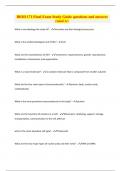
-
BIOD 171 Final Exam Study Guide questions and answers rated A+
- Exam (elaborations) • 23 pages • 2024
-
- $11.49
- + learn more
What is microbiology the study of? - microbes and their biological processes What is the smallest biological unit of life? - cell What are the characteristics of life? - movement, responsiveness, growth, reproduction, metabolism, homeostasis, and organization What is a macromolecule? - a complex molecule that is composed from smaller subunits What are the four main types of macromolecules? - protein, lipids, nucleic acids, carbohydrates What is the most prominent macromolecule in the body...
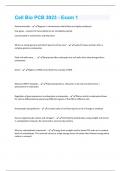
-
Cell Bio PCB 3023 - Exam 1 Questions And Answers With 100% Correct Answers
- Exam (elaborations) • 13 pages • 2024
- Available in package deal
-
- $7.99
- + learn more
Heterochromatin - Regions in chromosome where fibers are highly condensed Few genes - resistant to transcription by not completely exempt Concentrated in centromeres and telomeres What is a simple genome and which type of cell has one? - Codes for fewer proteins then a complex genome, prokaryotes Plant cell walls were.... - Reacquired after eukaryotes lost cell walls when they diverged from prokaryotes Genes - Regions of DNA transcribed into any type of RNA What are RNPs? Examples - Ribo...
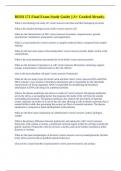
-
BIOD 171 Final Exam Study Guide || A+ Graded Already.
- Exam (elaborations) • 12 pages • 2024
- Available in package deal
-
- $11.49
- + learn more
What is microbiology the study of? correct answers microbes and their biological processes What is the smallest biological unit of life? correct answers cell What are the characteristics of life? correct answers movement, responsiveness, growth, reproduction, metabolism, homeostasis, and organization What is a macromolecule? correct answers a complex molecule that is composed from smaller subunits What are the four main types of macromolecules? correct answers protein, lipids, nuclei...
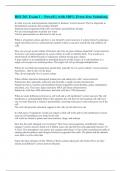
-
BIO 261 Exam 1 – Powell || with 100% Error-free Solutions.
- Exam (elaborations) • 15 pages • 2024
-
- $11.99
- + learn more
In what ways are microorganisms important to humans? correct answers They're important in fermentation reactions, they produce biofuel Studying microorganisms help with vaccination and antibiotic therapy We use microorganisms to purify our water Used in pasteurization so that food is safe to eat What is a bacterial colony and how is one formed? correct answers A colony forms by placing a single microbial cell on a solid nutrient medium where it can grow and divide into millions of cells. ...
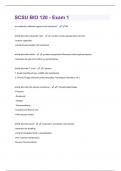
-
SCSU BIO 120 - Exam 1 Questions And Answers Rated A+
- Exam (elaborations) • 24 pages • 2024
- Available in package deal
-
- $7.99
- + learn more
are antibiotics effective against viral infections? - NO briefly describe eukaryotic cells - -contain nucleus (prokaryotes do not) -contain organelles -selectively permeable cell membrane briefly describe molds - -produce cytoplasmic filaments called hyphae/mycelia -reproduce by spore formation on aerial hyphae briefly describe T. Cruzi - 2 phases: 1. Acute (swelling of eye, cold/flu-like symptoms) 2. Chronic Chagas disease (cardiomyopathy, neurological disorders, etc.) briefly describe...
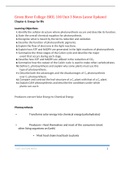
-
Green River College: BIOL 100 Unit 3 Notes Latest Updated,100% CORRECT
- Class notes • 116 pages • 2023
-
- $16.99
- 1x sold
- + learn more
Green River College: BIOL 100 Unit 3 Notes Latest Updated Chapter 6: Energy for life Learning Objectives: 1. Identify the cellular structure where photosynthesis occurs and describe its function. 2. State the overall chemical equation for photosynthesis. 3. Recognize what is meant by the terms reduction and oxidation. 4. Describe the function of photosynthetic pigments. 5. Explain the flow of electrons in the light reactions. 6. Explain how ATP and NADPH are generated in the light reac...
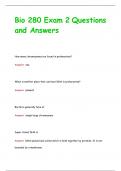
-
Bio 280 Exam 2 Questions and Answers
- Exam (elaborations) • 36 pages • 2024
- Available in package deal
-
- $13.49
- + learn more
How many chromosomes are found in prokaryotes? Answer> one What is another place that can have DNA in prokaryotes? Answer> plasmid Bacteria generally have a? Answer> single large chromosome Super Coiled DNA is Answer> DNA packed and coiled which is held together by proteins. It is not bounded by a membrane. Plasmids Answer> -Extrachromosomal circular DNA -Contain genes which are not necessary for the organism's survival but which may be useful to it (e.g antibiotic ...
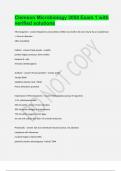
-
Clemson Microbiology 3050 Exam 1 with verified solutions.
- Exam (elaborations) • 16 pages • 2024
-
- $14.49
- + learn more
Microorganism Organisms and acellular entities too small to be seen clearly by an unaided eye; =<1mm in diameter often unicellular Cellular Fungi (yeasts + molds) protists (algae, protozoa, slime molds) bacteria (E. coli) Archaea (methanogens) Brainpower Read More Previous Play Next Rewind 10 seconds Move forward 10 seconds Unmute 0:00 / 0:15 Full screen Acellular Viruses (protein + nucleic acids) Viroids (RNA) Satellites (Nucleic Acid + RNA) Prions (inf...
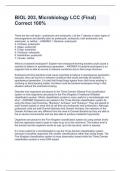
-
BIOL 203, Microbiology LCC (Final) Correct 100%
- Exam (elaborations) • 47 pages • 2024
- Available in package deal
-
- $15.49
- + learn more
There are two cell types - prokaryotic and eukaryotic. List the 7 classes or basic types of microorganisms and identify each as prokaryotic, eukaryotic, both prokaryotic and eukaryotic, or neither. - ANSWER 1. Bacteria- prokaryotic 2. Archaea- prokaryotic 3. Algae- eukaryotic 4. Fungi- eukaryotic 5. Protozoa- eukaryotic 6. Helminthes- eukaryotic 7. Viruses- neither What is a bacterial endospore? Explain how endospore-forming bacteria could cause a scientist to believe in spontaneous gen...
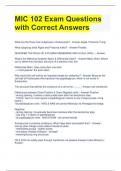
-
MIC 102 Exam Questions with Correct Answers
- Exam (elaborations) • 17 pages • 2023
- Available in package deal
-
- $13.99
- + learn more
MIC 102 Exam Questions with Correct Answers What are the three main subgroups of Eukaryotes? - Answer-Algae, Protozoa, Fungi What subgroup does Algae and Protozoa make? - Answer-Protists DESCRIBE THE ROLE OF A PLASMA MEMBRANE AND A CELL WALL. - Answer- What's the difference between Basic & Differential Stain? - Answer-Basic Stain: Allows you to determine the basic structure of a bacteria (rod, etc) Differential Stain: Uses more than one stain --> most popular: the gram stain. ...

Do you wonder why so many students wear nice clothes, have money to spare and enjoy tons of free time? Well, they sell on Stuvia! Imagine your study notes being downloaded a dozen times for $15 each. Every. Single. Day. Discover all about earning on Stuvia


